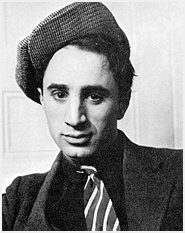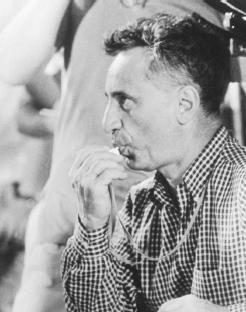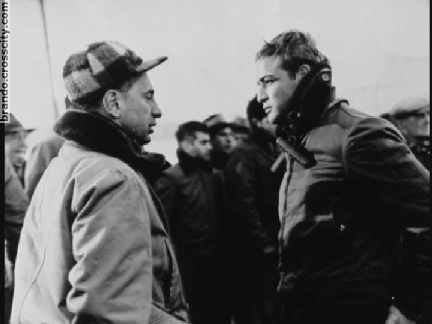 | US: Postwar Genres and Black List. End of the studio era |
|
Elia Kazan |
Jack Waltzer and Elia Kazan |
|
|
http://www.filmsite.org/onth.html |
Elia Kazan and Marlon Brando during the filming of "On The Waterfront |
Marlon Brando and Eva Marie Saint |
Postwar Boom.
Hollywood was powerful studio production system, making the American the only major national cinema in the West to preserve a direct continuity of tradition with its part after 1945.Only America was in a material position to provide high-quality films to a world hungryfor diversion.
Postwar Genres in the US.
Several basic types.The last complex were those that dealt melioristically with contemporary social problems and their resolution - "social consciousness", or "problem cycles", pictures (racism,political corruption)
1947 Crossfire (Edward Dmytryk)-melodrama about antiSemitizm in postwar America.
1947- Gentlemant''''s Agreement (Elia Kazan)-same
1949 -Pinky (Elia Kazan)- about black women
1949 - Home of the Brave (Mark Robson) - "Negro cycle"
1949 -All the King''''s Men (Robert Rossen)- a portrait of an aythentic American demagogue based upon the career of Louisiana governor Huey Long (novel of Robert Penn Warren)
1945 - The Lost Weekend (Billy Wilder) - the problems of alhogolism
1947 - Smash-Up (Stuart Heisler) - alhogolism
1948 -The Snake Pit (Anatole Litvak)-mental illness
1949-Knock on Any Door (Nickolas Ray) -juvenile delinquency
1947 -Brute Force (Julen Dassin) - prison injustice
There were several other films of the postwar era withvarious forms of social corruption as metaphors for more serious disorders in the cosmos and in the human soul and the nature of human evel.
1947 - Body and Soul (Abraham Polonsky)
1948 -Force of Evel (Abraham Polonsky)
1949 - The Set-Up (Robert Wise)
Closely related to the problem pictures was a series of semidocumentary crimemelodramas with social overtones-newsreels, based on the true story crime melodramas of the brutal and impersonal modern city, much of this films was shot by cinematographer William Daniels in cinema Verite fashion with higgen cameras. After 1948, the semidocumentary melodrama or crime trillers largery degenerated into stereotype.
1945 -The House of 92nd Street (Henry Hathaway)
1946 -13 Rue Madeleine (20th Century-Fox)
1947 -Boomerang (Elia Kazan)
1947 -Kiss of Death (Hathaway, 20th Century-Fox)
1948 -The Naked City (Jules dassin)
1948 - The Street with No Name (William Keighler)
1948 - T-Men (Anthony Mann)
1948 - Call Northside 777 (Hathaway and De Rochemond)
The influence of these of motion pictures continued into 1950s, as the documentary surfaces of fiction films like John Huston''''s The Asphalt Jungle (1950), Elia Kazan''''s On the Waterfront (1954), alfred Hitchcock''''s The Wrong Man (1957).
FILM NOIR
Semidocumentary crime trillers looks like Italian neorealism, like Dostoevsky and Dickens.This Was "film noir" (black film) - a strangle new mood of cynicism, darkness and ets.The most important crime writers: Dashiell Hammett, Raymond Chandler, James M.Cain - whose books were adopted in film noir.Like the novels, these films were characterized by a downbeatatmosphere and graphic violence, and they carried postwar Americam pessimism or nihilism in the world of corruption. Their basic was the the depth of human depravity and utterly unheroic nature og human beings under unique horrors of World War II. These films are often set in southern California: antiheroes in the urban American jungle.Universal horror cycle.The noir directors Fritz Lang, Robert Siodmak, Billy Wilder, OttoPreminger< John Brahm and ets with influence by the UFA studio style.1944 Double Indemnity (Billy Wilder)
Cynical films:
1943 - High Sierra (Raoul Walsh)
1942 - This Gun for Hire (Frank Tuttle)
The Blacklist
American Coold War with the Soviet Union began in 1947, when Stalin refused to assept the Marshall Plan for the Soviet Union or any of its satellites.But, of course, Soviet-American tensions had been mounting ever since the Bolshevic Revolution. The half-baked nation that members of the American Communist Party were widespread during this era and would result in the convintion of Alger Hiss (1948), the rise and fall of Senator Joseph R. McCarty (1950-54).There was an anti-New-Deal blacklist that had been building since 1930s and Hollywood had it for key industry personnel.
In 1947 the House Committee on Un-American Activities (HUAC)- about "communism in motion pictures" (communist propaganda in the late 1940s, because the American film industry was one of the most conservative elements in the country).there were, however, such as the problem pictures and the semidocumentary melopdramas, and there were the apolitical film noir, there were also pro-Russian films made at the OWI''''s during the war.
In September 1947 the tragicomedy began as the committee subpoenaed 41 witnesses. They proved their patriotism by people whom they identified as leftists ("is one of the main centers of Communist activity in America"), Disney testified that the Screen Cartoonists Guild was Communist-dominated. There was question about their alleged Communist party membership - the German emigre playwright bertold Brecht, the screen writers Alvah Bessie, Lester Cole, Ring Landner Jr, John Howars Lawson, Albert Maltz, Samuel Ornitz, Adrian Scott, Dalton Trumbo and ets., and Hollywood liberals John Huston, William Wyler, Gene Kelli...- the now-famous Hollywood Ten listed above (less Brecht), ten would soon go to jail for contempt of Congress. The commmittee''''s action was scandalous, but its meaning was crystal clear:HUAC wished to purge Hollywood and the entire country of any and all liberal tendencies by creating and then exploiting anticommunist hysteria. The threat of state censorship loomed, and panic broke out in the nation''''s most image-conscious industry, which was already plagued by antitrast actions, unemployment, and rapidy declining profits.
Hollywood closed ranks against some of the most talanted artists it had ever known. The 50 members of the Motion Picture Association of America (MPAA) and the Association of Motion Picture Producers (representing the industry ''''s most powerful executives: Eric Johnston, Nicholas M.Schenck, Harry Cohn, Joseph M.Schenk, Walter Wanger, Samuel Golswyn, Henry Hinsberg, Albert Warner, Louis B.Mayer, Dore Schary, William Gortz and ets.) prodused the Waidorf Statement, refusing to reemploy any one of them "until such time as he is acquitted or has purged himself of contempt and declares under oath that he is not a Communist." This was the beginning of the infamous practice of blacklisting, which brought to the end one of the most creative periods in the history of American film.In 1950s 324 persons had been firedby the studios and were no longer permittedto work in the American film industry:
1950 - The Lawless (Joseph Losey)
1947 - Another Part of the Forest ( Michael Gordon)
1948 - The Naked City (Juless Dassin)
1948 -Forse of Evel (abraham Polonsky)
1944- The Master Race (Herbert Biberman) and ets. Its was for scree4n writers too.The highly visible actors and directors were doomed to unemployment, some lost their lives or died as a result of the stress - it was moral catastrophe, they were the victims of the blacklisting, who lost their jobs.
Blacklisting was only in 1950s, but Abraham Polonsky, for example, was not able to direct until 1969, when his Tell Them Willie Boy Is Here - 21 years after last his film!!!American cinema lost the individual talant.
Arrival of Television
Jack Waltzer is a lifetime member of the Actors Studio, and trained intensively for many years with America''s foremost teachers and directors of the Stanislavsky System. These include Stella Adler, Sanford Meisner, Lee Strasberg, Bobby Lewis, Uta Hagen and Elia Kazan, among others - http://www.jackwaltzer.com/about.html.
Elia Kazan - http://www.filmreference.com/Directors-Jo-Ku/Kazan-Elia.html
Elia Kazan
Ads by Google
"Notes On A Scandal" - Starring Judi Dench, Bill Nighy and Cate Blanchett. Opens This December (www.FoxSearchlight.com)
Directing School - Hands-on intensive film workshops NYC, Hollywood, Harvard, Paris, UK (www.NYFA.com)
Film Locations Wanted - All types of locations needed List your home and make thousands! (www.madisonlocations.com)
--------------------------------------------------------------------------------
Nationality: American. Born: Elia Kazanjoglou in Constantinople (now Istanbul), Turkey, 7 September 1909; moved with family to New York, 1913. Education: Mayfair School; New Rochelle High School, New York; Williams College, Massachusetts, B.A. 1930;
Yale Drama School, 1930¢32. Family: Married 1) Molly Day Thatcher, 1932 (died 1963), two sons, two daughters; 2) actress Barbara Loden, 1967 (died 1980), one son; 3) Frances Rudge, 1982. Career: Actor, property manager, then director, Group Theatre, New York, from 1933; stage director, including plays by Tennessee Williams and Arthur Miller, 1935 through 1960s; co-founder, with Cheryl Crawford, Actors'' Studio, New York, 1948; appeared voluntarily before HUAC, admitting membership of Communist Party, 1934¢36, and naming fellow members, 1952; began career as novelist, 1961; left Actors'' Studio to direct newly formed Lincoln Center Repertory Company, 1962¢64. Awards: Many awards for theatre work; Academy Award for Best Director, and Best Direction Award, New York Film Critics, for Gentleman''s Agreement, 1947; International Prize, Venice Festival, for Panic in the Streets, 1950; Special Jury Prize, Venice Festival, for A Streetcar Named Desire, 1951; Oscar for Best Director, and Most Outstanding Directorial Achievement, Directors Guild of America, for On the Waterfront, 1954; Honorary doctorates from Wesleyan University, Carnegie Institute of Technology, and Williams College; Academy Award for Lifetime Achievement, 1999. Address: c/o 432 W. 44th St., New York, NY 10036, U.S.A.
Films as Director:
1937 The People of the Cumberlands (+ sc) (short)
1941 It''s up to You
1945 A Tree Grows in Brooklyn
1947 The Sea of Grass; Boomerang; Gentleman''s Agreement
1949 Pinky
1950 Panic in the Streets
1952 A Streetcar Named Desire; Viva Zapata!; Man on a Tightrope
1954 On the Waterfront
1955 East of Eden (+ pr)
1956 Baby Doll (+ pr, co-sc)
1957 A Face in the Crowd (+ pr)
1960 Wild River (+ pr)
1961 Splendour in the Grass (+ pr)
1964 America, America (+ sc, pr)
1969 The Arrangement (+ pr, sc)
1972 The Visitors
1976 The Last Tycoon
1978 Acts of Love (+ pr)
1982 The Anatolian (+ pr)
1989 Beyond the Aegean
Other Films:
1934 Pie in the Sky (Steiner) (short) (role)
1940 City for Conquest (Litvak) (role as Googie, a gangster)
1941 Blues in the Night (Litvak) (role as a clarinetist)
1951 The Screen Director (role as himself)
1984 Sanford Meisner: The American Theatre''s Best Kept Secret (Doob) (role as a himself)
1989 L'' Hķritage de la chouette (The Owl''s Legacy) (Marker) (role)
1998 Liv till varje pris (Jarl) (role as himself)
Publications
By KAZAN: booksŚ
America America, New York, 1961.
http://www.reelclassics.com/Directors/Kazan/kazan.htm - Kazan, N.Wood and films
On the Waterfront (1954) is a classic, award-winning, controversial film directed by Elia Kazan - a part drama and part gangster film. The authentic-looking, powerful film is concerned with the problems of trade unionism, corruption and racketeering. And it is set on New York''s oppressive waterfront docks, where dock workers struggled for work, dignity, and to make ends meet under the control of hard-knuckled, mob-run labor unions that would force them to submit to daily ''shape-ups'' by cruel hiring bosses - http://www.filmsite.org/onth.html, http://www.leninimports.com/on_the_waterfront.html
http://brando.crosscity.com/Brando/Main.aspx?Page=Articles/Kazan.ascx
http://tigger.uic.edu/~rjensen/kazan/kazan.html
http://afi.chadwyck.com/info/photos.htm
HomeVideo (Russia)
Hollywood 10: The genesis of the Hollywood Blacklist
Film Noir
Elia Kazan
In Memoriam Goodbye to Elia Kazan





